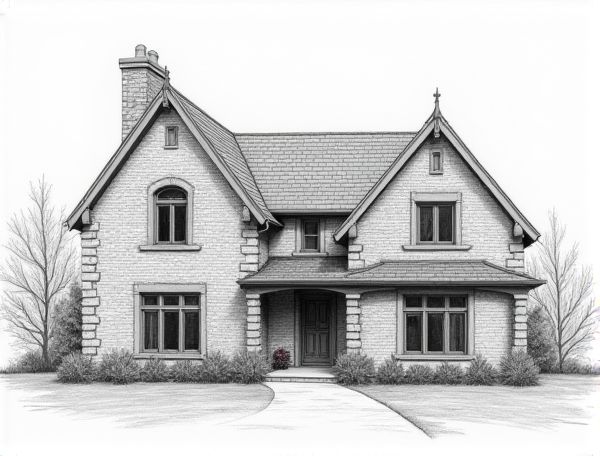
Photo illustration: Flemish bond brick home design with Flemish gable
Flemish bond brick home design offers a timeless pattern that enhances architectural elegance, especially when paired with a distinctive Flemish gable to create visual interest and historic charm. Discover how incorporating these classic elements can elevate your home's curb appeal and structural beauty by reading more in the article.
Introduction to Flemish Bond Brickwork
Flemish Bond brickwork features an alternating pattern of headers and stretchers in each row, creating a strong and visually appealing wall structure. This design enhances the durability and aesthetic value of your home, combining traditional craftsmanship with modern building standards. Understanding Flemish Bond techniques can elevate your residential project by ensuring both structural integrity and timeless elegance.
Historical Origins of Flemish Bond
Flemish Bond, characterized by alternating headers and stretchers in each row, originated in 17th-century Europe, particularly in Flanders, Belgium, where it enhanced both the aesthetic appeal and structural stability of brick walls. This masonry technique became widely adopted in England and colonial America during the 18th century, signifying craftsmanship and durability in architectural design. Understanding the historical origins of Flemish Bond can enrich Your home design by incorporating a timeless pattern that reflects cultural heritage and architectural sophistication.
Key Features of Flemish Bond in Home Design
Flemish bond in home design creates a distinctive pattern by alternating headers and stretchers in each row, enhancing both aesthetic appeal and structural stability. This brickwork technique improves wall strength and offers a timeless, classic look that complements traditional and contemporary architectural styles.
The Distinctive Appeal of Flemish Gables
Flemish gables showcase intricate stepped designs that add historic charm and architectural interest to home exteriors. Their unique silhouette enhances curb appeal, blending traditional craftsmanship with modern aesthetics. Incorporating Flemish gables elevates property value by creating visually striking facades.
Combining Flemish Bond and Flemish Gables
Combining Flemish Bond brickwork with Flemish gables creates a visually striking architectural design that enhances both texture and silhouette. This blend emphasizes craftsmanship and historic charm, adding aesthetic value and structural integrity to your home. Incorporating these elements can significantly elevate the curb appeal and character of your property.
Materials Used in Flemish Bond Brick Homes
Flemish bond brick homes utilize a distinctive pattern of alternating headers and stretchers in each row, enhancing both aesthetic appeal and structural stability. Common materials include high-quality clay bricks with a smooth finish, paired with durable lime or cement mortar to ensure long-lasting resilience. Your choice of these materials significantly impacts the home's visual texture and overall strength, making them essential for authentic Flemish bond construction.
Construction Techniques for Flemish Bond Walls
Flemish bond walls showcase an alternating pattern of stretchers and headers in each course, enhancing both structural integrity and aesthetic appeal. This technique requires precise bricklaying skill to ensure proper alignment and consistent mortar joints, optimizing durability and weather resistance. Incorporating Flemish bond in your home design elevates visual texture while maintaining robust construction standards.
Architectural Styles Complementing Flemish Designs
Dutch Colonial Revival and Georgian architectural styles complement Flemish designs through their use of brick facades, steeply pitched roofs, and symmetrical layouts. Flemish Renaissance elements such as stepped gables and intricate masonry details enhance both styles by adding historical depth and texture. Incorporating timber framing and large, mullioned windows further unites these architectural traditions, creating cohesive and visually rich home designs.
Modern Adaptations of Flemish Bond and Gables
Modern adaptations of Flemish bond in home designing emphasize blending traditional brick patterns with contemporary materials like glass and steel to create visually striking facades. Incorporating gables in modern architecture often involves sleek, minimalistic lines and expansive windows that maximize natural light while preserving the classic pitched roof silhouette. These design choices enhance aesthetic appeal and structural functionality, making them popular in urban residential developments.
Maintenance Tips for Flemish Bond Brick Homes
Regular inspection of mortar joints in Flemish bond brick homes is crucial to prevent water infiltration and structural damage. Use a soft brush and mild detergent to clean the bricks, avoiding high-pressure washing which can erode the mortar. Applying a breathable sealant enhances durability by protecting bricks from moisture while allowing trapped vapor to escape.
 homedesy.com
homedesy.com